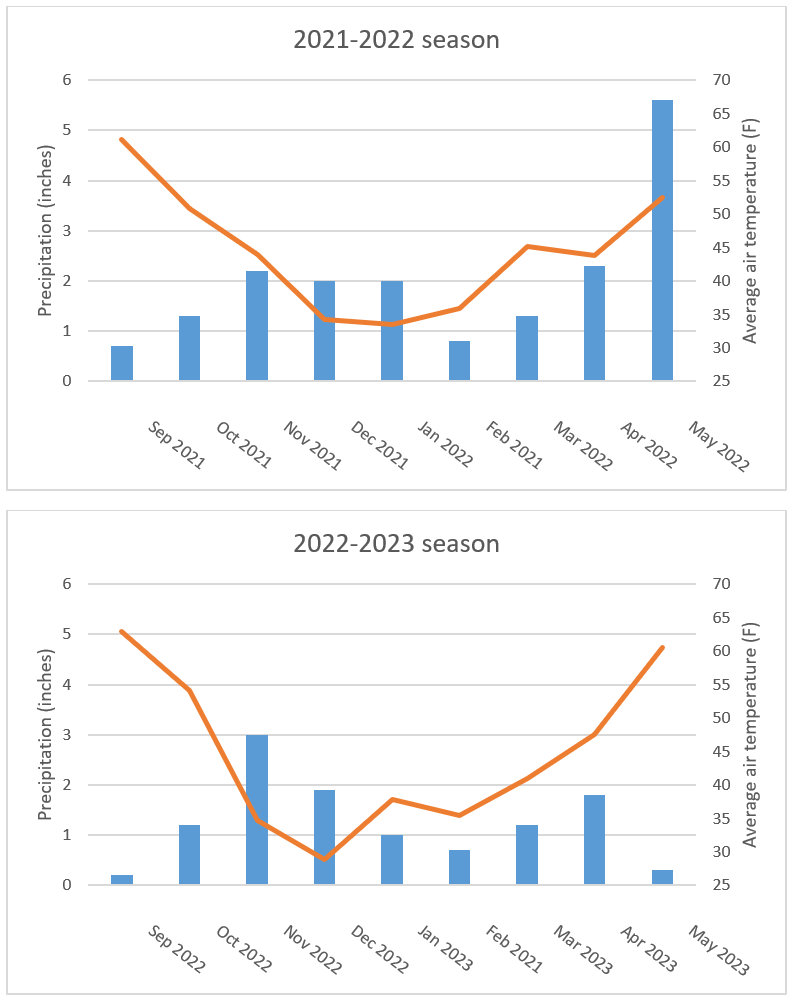Contributed by Judit Barroso, Associate Professor, Columbia Basin Agricultural Research Center — Oregon State University
There are many factors that can impact chemical weed control, such as temperatures before and after applications, herbicide coverage, or type of adjuvant used. However, one of the most important factors is the growth stage or size of the weed. I am sure that many of you have experienced improved control when you are trying to control young weeds compared with more “grown up” weeds. In fact, I do not think I have found an herbicide label that does not talk about weed size, right?
To get as much as possible from a post-emergence herbicide application, besides applying it when weeds are small/young, we normally want as many weeds as possible, with the idea of having to spray the fallow fields the fewest amount of times or having the least untreated residual infestation in the crop. However, how weeds emerge in each particular year can be different depending on the weather, especially in dryland where soil moisture is a limiting factor for germination.
During the past two years, we have been studying the emergence of several problem grass weeds in wheat, such as feral rye, jointed goatgrass, or downy brome (cheatgrass), to understand their germination in the region and help optimize control strategies. In the 2021-2022 season, 70% of the germination occurred before November 5 (Figure 1a), while in the 2022-2023 season, that peak of germination did not happen until January (Figure 1b). Comparing those germination patterns with the weather (Figure 2), we observe that in the 2022-2023 season, there was less rain accumulated before November and temperatures dropped drastically that month and did not recover until January. However, in the 2021-2022 season, November had an average temperature of 44oF compared to 34oF in January.
We also observe that beyond mid-March in both years, there was not much germination of any of the species, in line with being qualified as winter annuals. However, I want you to notice that the graphs in Figure 1 are percentage of germination, which means that if the soil seed bank is large, 5% germination in late March could still mean a significant amount of plants in spring. A single downy brome plant, for example, can easily produce 250-300 seeds, so a 5% germination rate could mean 12-15 potential seeds germinating in spring. The last thing I would like to mention from this study is how similar the volunteer wheat’s germination (orange bars) is compared to the other three weed species, and particularly to downy brome (yellow bars).

Figure 1. Percentage of grass germination in fallow at the Columbia Basin Agricultural Research Center (CBARC), Adams, OR, during the 2021-2022 (a) and 2022-2023 (b) growing seasons. The months indicated in italic were the times when we did the samplings, the day of the sampling is also indicated in those months. The species sampled were feral rye, volunteer wheat (VolWheat), jointed goatgrass (JGG), and downy brome (cheatgrass). The vertical axis (Y-axis) is percentage of plant germination.

Figure 2. Monthly precipitation in inches (blue bars) and average air temperature in degrees Fahrenheit (orange line) during the 2021-2022 and 2022-2023 growing seasons at the Columbia Basin Agricultural Research Center (CBARC), Adams, OR.
Weed scientists in the region have been discussing the possibility of annually announcing when we observe important weed species starting to germinate, similar to what plant pathologists do with disease detection. Do you think that sending notifications about when the main weeds start to germinate each year could be useful to you? Or because weeds are more visible and seem to always be present, would it not be very worthwhile?
As always, your feedback about this question or the content of this small post is welcome. If you have questions do not hesitate to contact me via email (Judit.barroso@oregonstate.edu) or phone (541 278 4394).